Page 2 of 392
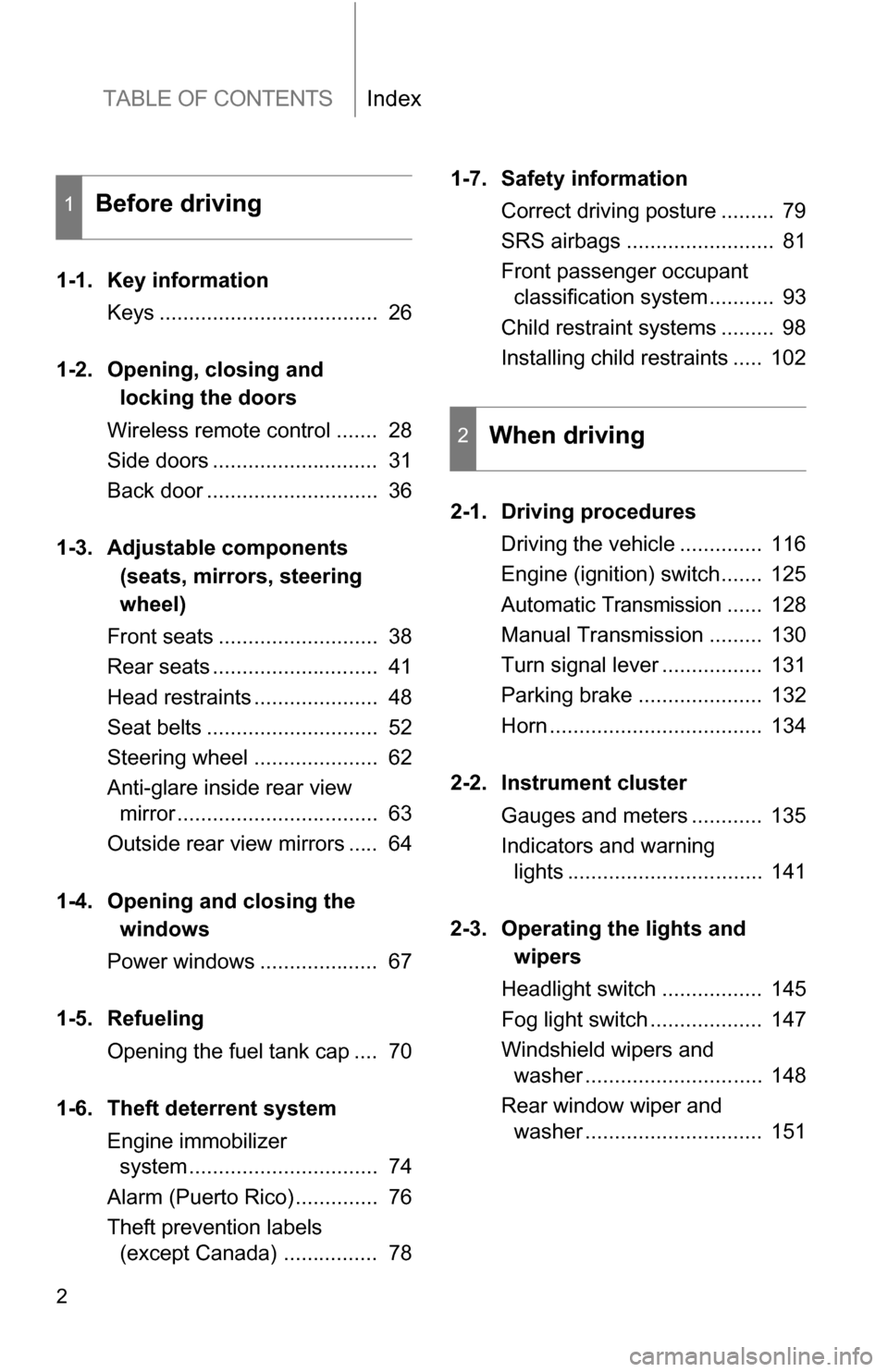
TABLE OF CONTENTSIndex
2
1-1. Key informationKeys ..................................... 26
1-2. Opening, closing and
locking the doors
Wireless remote control ....... 28
Side doors ............................ 31
Back door ............................. 36
1-3. Adjustable components
(seats, mirrors, steering
wheel)
Front seats ........................... 38
Rear seats ............................ 41
Head restraints ..................... 48
Seat belts ............................. 52
Steering wheel ..................... 62
Anti-glare inside rear view mirror .................................. 63
Outside rear view mirrors ..... 64
1-4. Opening a nd closing the
windo ws
Power windows .................... 67
1-5. Refueling Opening the fuel tank cap .... 70
1-6. Theft deterrent system Engine immobilizer system ................................ 74
Alarm (Puerto Rico).............. 76
Theft prevention labels (except Canada) ................ 78 1-7. Safety information
Correct driving posture ......... 79
SRS airbags ......................... 81
Front passenger occupant classification system ........... 93
Child restraint systems ......... 98
Installing child restraints ..... 102
2-1. Driving procedures Driving the vehicle .............. 116
Engine (ignition) switch....... 125
Automatic
Transmission...... 128
Manual Transmission ......... 130
Turn signal lever ................. 131
Parking brake ..................... 132
Horn .................................... 134
2-2. Instrument cluster Gauges and meters ............ 135
Indicators and warning lights ................................. 141
2-3. Operating the li ghts and
wipers
Headlight switch ................. 145
Fog light switch ................... 147
Windshield wipers and washer .............................. 148
Rear window wiper and washer .............................. 151
1Before driving
2When driving
Page 4 of 392
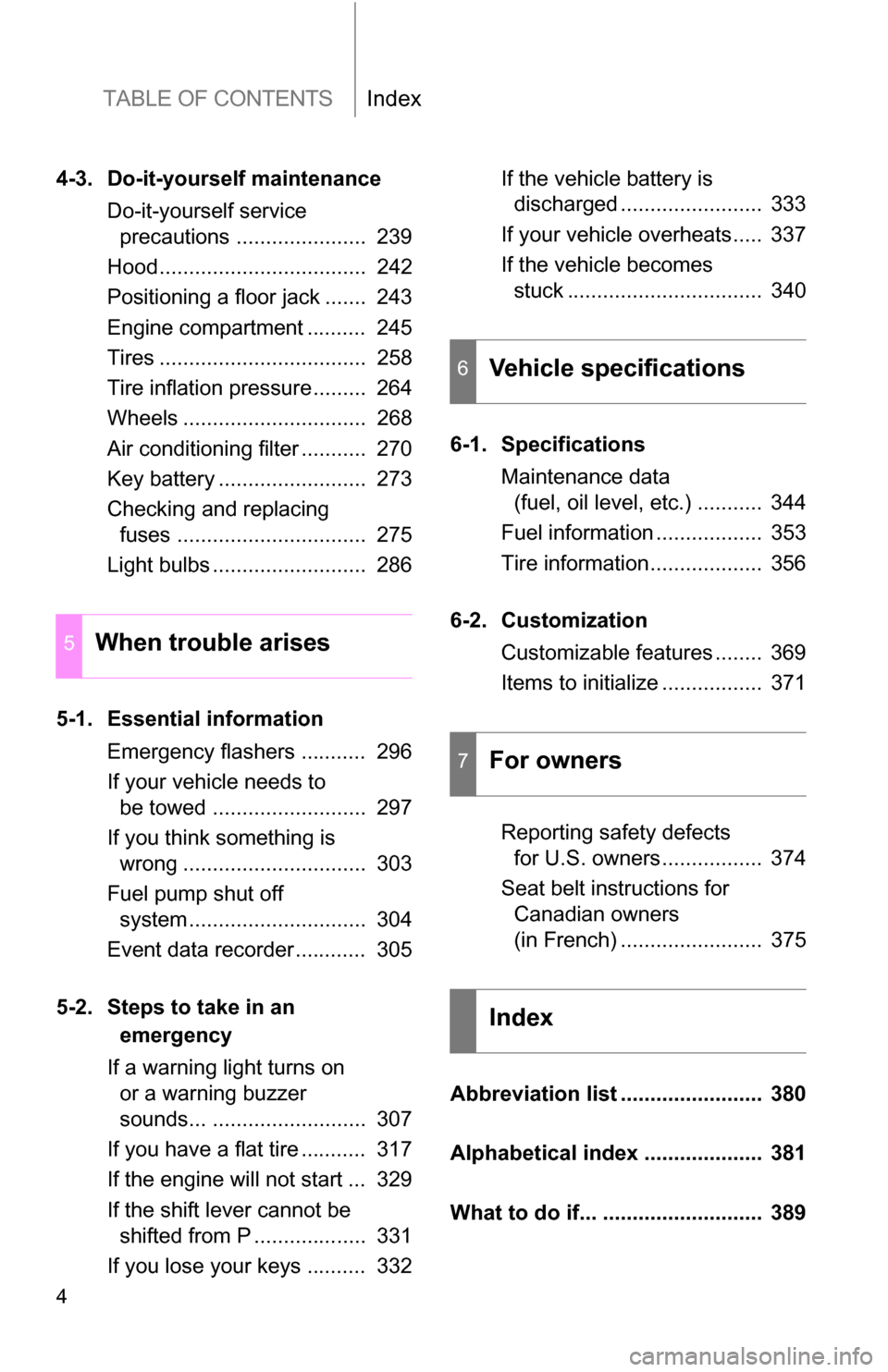
TABLE OF CONTENTSIndex
4
4-3. Do-it-yourself maintenanceDo-it-yourself service precautions ...................... 239
Hood................................... 242
Positioning a floor jack ....... 243
Engine compartment .......... 245
Tires ................................... 258
Tire inflation pressure......... 264
Wheels ............................... 268
Air conditioning filter ........... 270
Key battery ......................... 273
Checking and replacing fuses ................................ 275
Light bulbs .......................... 286
5-1. Essential information Emergency flashers ........... 296
If your vehicle needs to be towed .......................... 297
If you think something is wrong ............................... 303
Fuel pump shut off system .............................. 304
Event data recorder............ 305
5-2. Steps to take in an emergency
If a warning light turns on or a warning buzzer
sounds... .......................... 307
If you have a flat tire ........... 317
If the engine will not start ... 329
If the shift lever cannot be shifted from P ................... 331
If you lose your keys .......... 332 If the vehicle battery is
discharged ........................ 333
If your vehicle overheats..... 337
If the vehicle becomes stuck ................................. 340
6-1. Specifications Maintenance data (fuel, oil level, etc.) ........... 344
Fuel information .................. 353
Tire information................... 356
6-2. Customization Customizable features ........ 369
Items to initialize ................. 371
Reporting safety defects for U.S. owners ................. 374
Seat belt instructions for Canadian owners
(in French) ........................ 375
Abbreviation list ........................ 380
Alphabetical index .................... 381
What to do if... ........................... 389
5When trouble arises
6Vehicle specifications
7For owners
Index
Page 22 of 392
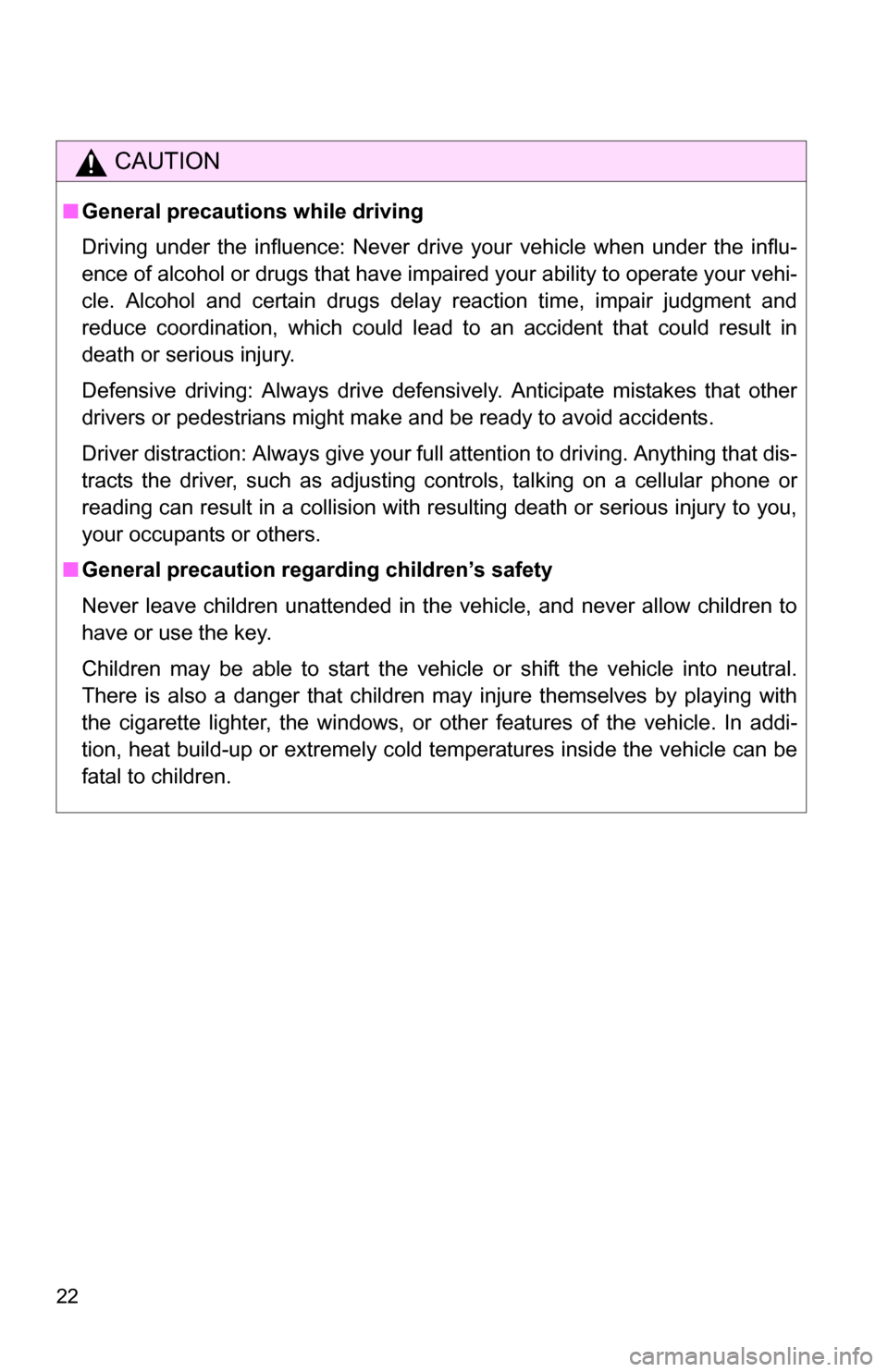
22
CAUTION
■General precautions while driving
Driving under the influence: Never drive your vehicle when under the influ-
ence of alcohol or drugs that have impaired your ability to operate your vehi-
cle. Alcohol and certain drugs delay reaction time, impair judgment and
reduce coordination, which could lead to an accident that could result in
death or serious injury.
Defensive driving: Always drive defensively. Anticipate mistakes that other
drivers or pedestrians might make and be ready to avoid accidents.
Driver distraction: Always give your full attention to driving. Anything that dis-
tracts the driver, such as adjusting controls, talking on a cellular phone or
reading can result in a collision with resulting death or serious injury to you,
your occupants or others.
■ General precaution regarding children’s safety
Never leave children unattended in the vehicle, and never allow children to
have or use the key.
Children may be able to start the vehicle or shift the vehicle into neutral.
There is also a danger that children may injure themselves by playing with
the cigarette lighter, the windows, or other features of the vehicle. In addi-
tion, heat build-up or extremely cold temperatures inside the vehicle can be
fatal to children.
Page 25 of 392
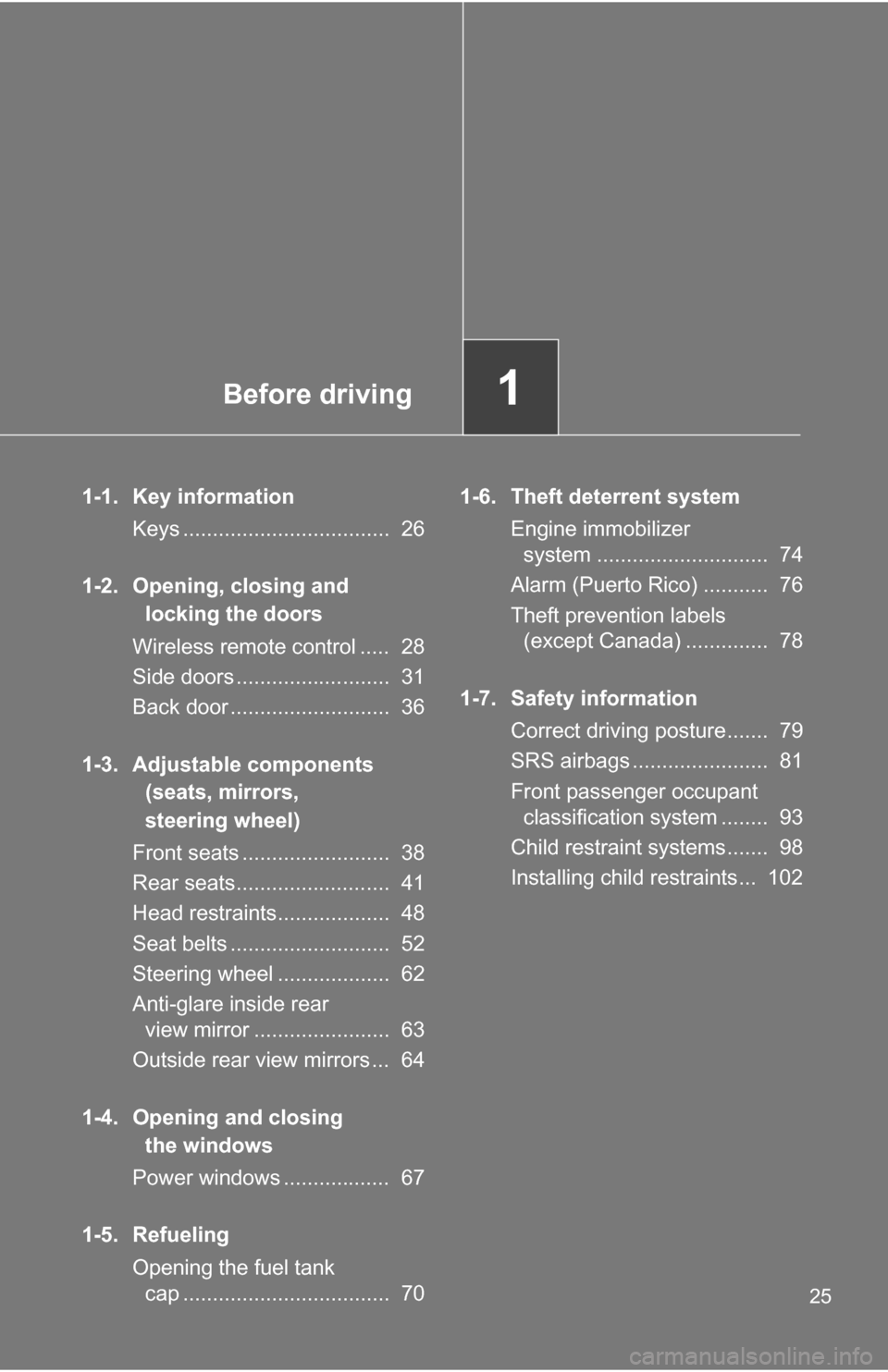
Before driving1
25
1-1. Key informationKeys ................................... 26
1-2. Opening, closing and locking the doors
Wireless remote control ..... 28
Side doors .......................... 31
Back door ........................... 36
1-3. Adjustable components (seats, mirrors,
steering wheel)
Front seats ......................... 38
Rear seats.......................... 41
Head restraints................... 48
Seat belts ........................... 52
Steering wheel ................... 62
Anti-glare inside rear view mirror ....................... 63
Outside rear view mirrors ... 64
1-4. Opening and closing the windows
Power windows .................. 67
1-5. Refueling Opening the fuel tank cap ................................... 70 1-6. Theft deterrent system
Engine immobilizer system ............................. 74
Alarm (Puerto Rico) ........... 76
Theft prevention labels (except Canada) .............. 78
1-7. Safety information Correct driving posture....... 79
SRS airbags ....................... 81
Front passenger occupant classification system ........ 93
Child restraint systems....... 98
Installing child restraints... 102
Page 26 of 392
26
1-1. Key information
Keys
The following keys are provided with the vehicle.
Vehicles without engine immobilizer system
Master keys
Key number plate
Vehicles with engine immobilizer system (type A) Master keys (with wireless
remote control function)
Operating the wireless remote
control function (P. 28)
Va l e t k e y
Key number plate
Vehicles with engine immobilizer system (type B) Master keys
Va l e t k e y
Key number plate
Page 27 of 392
27
1-1. Key information
1
Before driving
■
Key number plate
Keep the plate in a safe place such as your wallet, not in the vehicle. In the
event that a key is lost, a new key can be made by your Toyota dealer using
the key number plate. ( P. 332)
NOTICE
■To prevent key damage (vehicles with engine immobilizer system)
● Do not subject the keys to strong shocks, expose them to high tempera-
tures by placing them in direct sunlight, or get them wet.
● Do not expose the keys to electromagnetic materials or attach any mate-
rial that blocks electromagnetic waves to the key surface.
Page 28 of 392
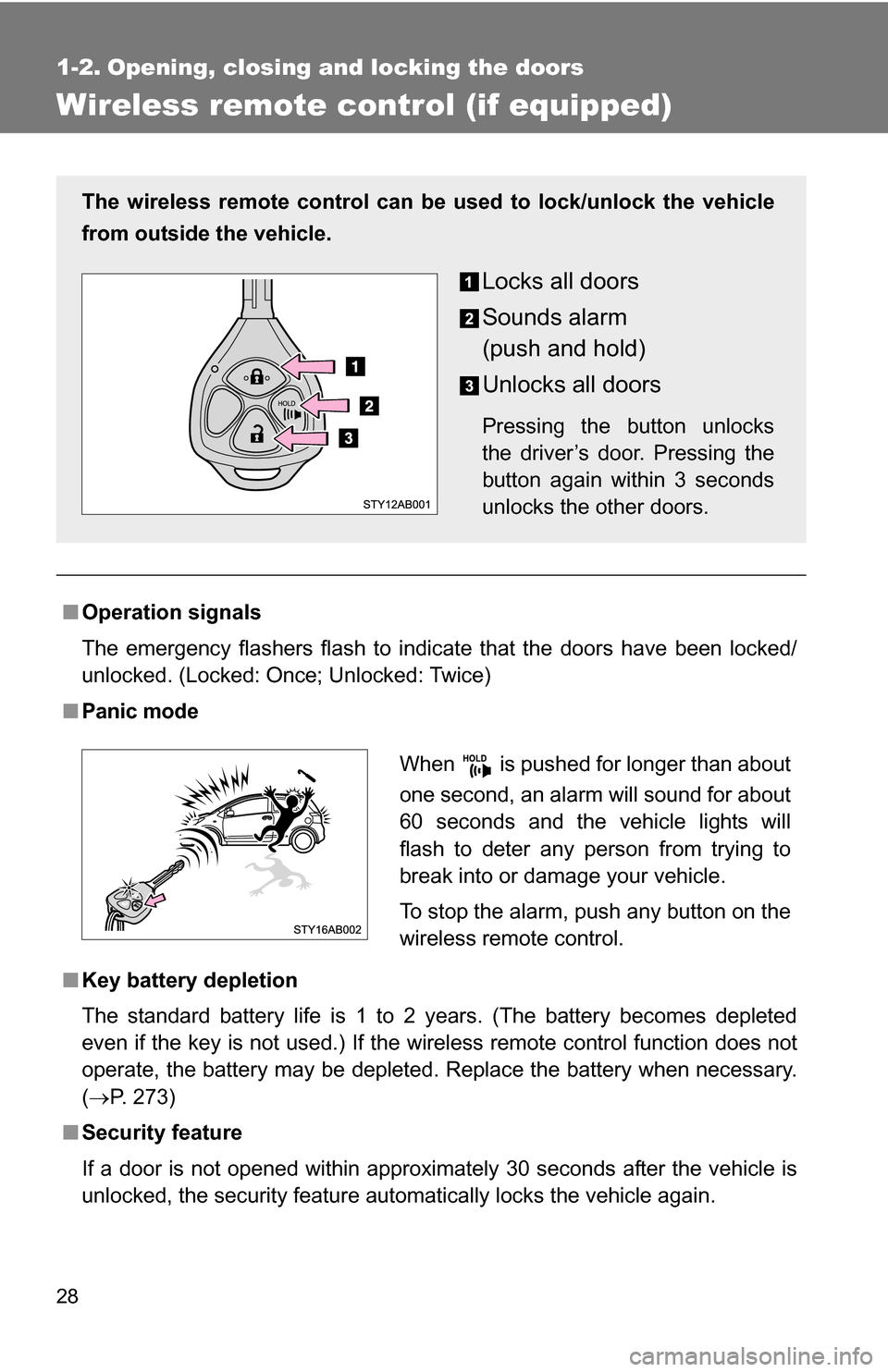
28
1-2. Opening, closing and locking the doors
Wireless remote control (if equipped)
■Operation signals
The emergency flashers flash to indicate that the doors have been locked/
unlocked. (Locked: Once; Unlocked: Twice)
■Panic mode
■Key battery depletion
The standard battery life is 1 to 2 years. (The battery becomes depleted
even if the key is not used.) If the wireless remote control function does not
operate, the battery may be depleted. Replace the battery when necessary.
(P. 273)
■ Security feature
If a door is not opened within approximately 30 seconds after the vehicle is
unlocked, the security feature automatically locks the vehicle again.
The wireless remote control can be used to lock/unlock the vehicle
from outside the vehicle.
Locks all doors
Sounds alarm
(push and hold)
Unlocks all doors
Pressing the button unlocks
the driver’s door. Pressing the
button again within 3 seconds
unlocks the other doors.
When is pushed for longer than about
one second, an alarm will sound for about
60 seconds and the vehicle lights will
flash to deter any person from trying to
break into or damage your vehicle.
To stop the alarm, push any button on the
wireless remote control.
Page 29 of 392
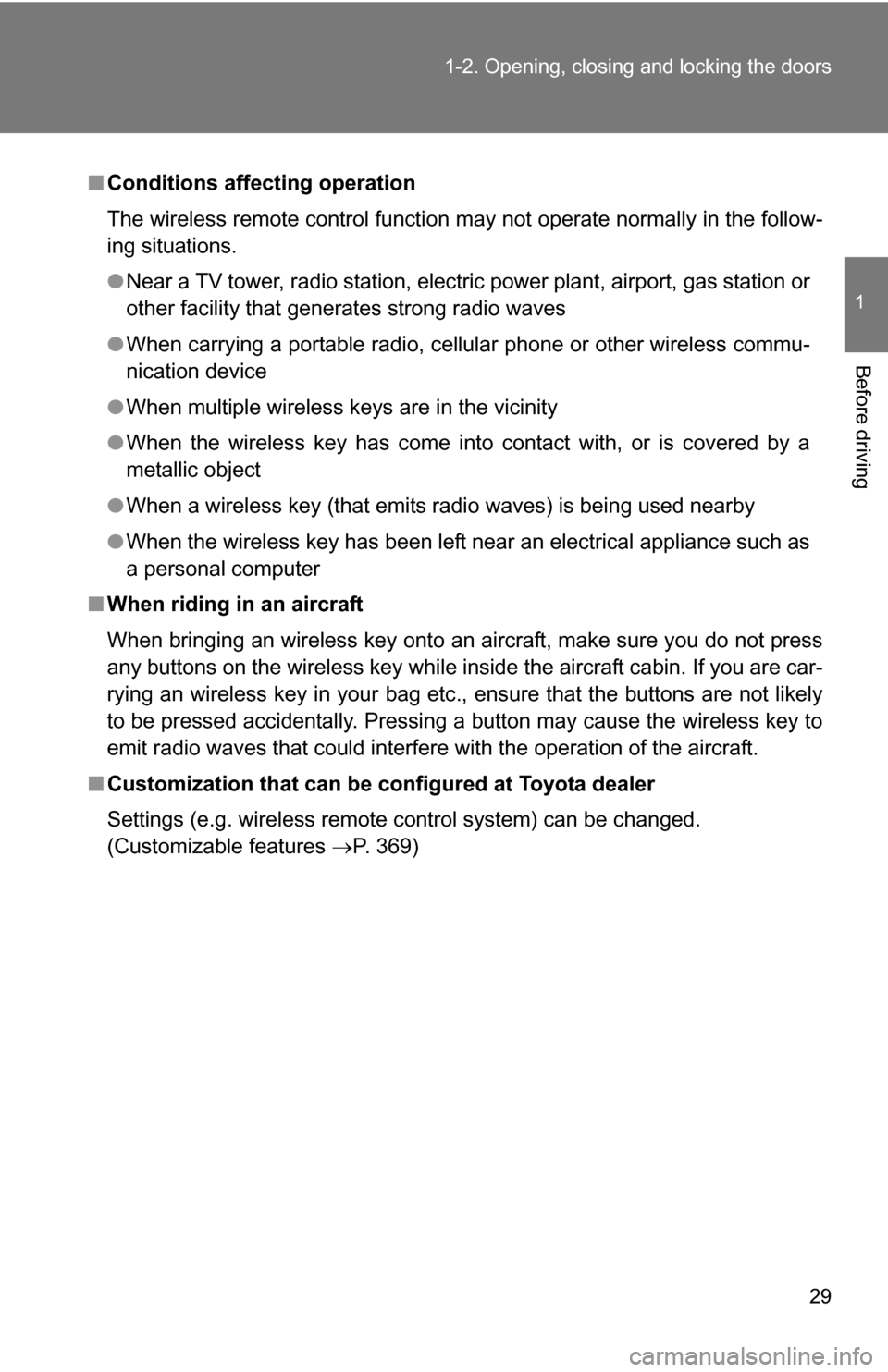
29
1-2. Opening, closing and locking the doors
1
Before driving
■
Conditions affecting operation
The wireless remote control function may not operate normally in the follow-
ing situations.
●Near a TV tower, radio station, elec tric power plant, airport, gas station or
other facility that generates strong radio waves
● When carrying a portable radio, cell ular phone or other wireless commu-
nication device
● When multiple wireless keys are in the vicinity
● When the wireless key has come into contact with, or is covered by a
metallic object
● When a wireless key (that emits radio waves) is being used nearby
● When the wireless key has been left near an electrical appliance such as
a personal computer
■ When riding in an aircraft
When bringing an wireless key onto an aircraft, make sure you do not press
any buttons on the wireless key while inside the aircraft cabin. If you are car-
rying an wireless key in your bag etc., ensure that the buttons are not likely
to be pressed accidentally. Pressing a button may cause the wireless key to
emit radio waves that could interfere with the operation of the aircraft.
■ Customization that can be co nfigured at Toyota dealer
Settings (e.g. wireless remote control system) can be changed.
(Customizable features P. 369)